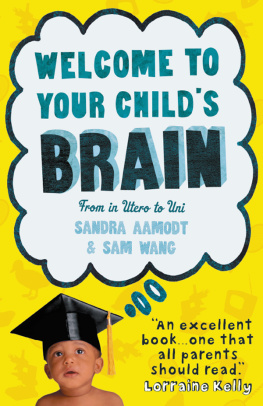BIBLIOGRAPHY
Aoki, C., and P. Steketvitz, Plasticity in Brain Development, Scientific American 259(6), 56-64, 1988.
Arnheim, D. D., and W. A. Sinclair, The Clumsy Child (second edition), St. Louis, C. V. Mosby, 1979.
Ayres, A. J., Sensory Integration and Learning Disorders, Los Angeles, Western Psychological Services, 1974.
Bakker, R. D. J., Neuropsychological Treatment for Dyslexia, Oxford, Oxford University Press, 1990.
Brard, G., Hearing Equals Behavior, Connecticut, Keats Publishing, 1993.
Berthoz, Alain, The Brains Sense of Movement, Boston, Harvard University Press, 2000.
Blythe, S. A. Goddard, The Well Balanced Child, Hawthorne Press, 2004.
Cade, R., Research on Autism and Schizophrenia, Florida, University of Florida, 1998-99.
Campbell, D., The Mozart Effect, New York, Avon Books, 1997.
Chandler, E. H., The Shape of Intelligence, London, Allen & Unwin, 1970.
Delacato, C. H., The Diagnosis of Speech and Reading Problems. Springfield, Charles C. Thomas, 1970. The Ultimate Stranger, Your Autistic Child, New York, Doubleday, 1974.
Dengate, S., Fed Up, Sydney, Random House, 1998.
Doidge, Norman, The Brain that Changes Itself, Melbourne, Scribe Publications, 2007.
Domain, R., The Philosophical Core, in The Listening Program, Philadelphia, Advanced Brain Technologies, 1999.
Doman, G., D. Doman, and B. Hagy, How to Teach your Child to be Physically Superb, Philadelphia, The Better Baby Press, 1988.
Epstein, H. T., Stages in Human Brain Development, Developmental Brain Research 30, 114-19, 1986.
Ganong, W. F., Review of Medical Physiology, Englewood Cliffs, Prentice Hall, 1987.
Gesell, A., Infant Development, Connecticut, Greenwood Press, 1952.
Getman, G., How to Develop Your Childs Intelligence, Los Angeles, Optometric Extension Program Foundation, 1995.
Glascoe, F. P., The value of parents concerns to detect and address developmental and behavioral problems, Journal of Pediatrics and Child Health 35 (1), 1-8, 1999.
Goddard, S. A., A Teachers Window into a Childs Mind, Eugene, Fern Ridge Press, 1996.
Healy, J. M., Endangered Minds, Touchstone, Simon & Schuster, 1990.
Held, R., Plasticity in Sensory Motor Systems, Readings from Scientific American, 1965.
Holt, T. K. S., Child Development, Oxford, Butterworth and Heinemann, 1993.
Ibuka, M., Kindergarten is Too Late, London, Sphere Books, 1977.
Kandell, E. R., J. H. Schwartz, and T. M. Jessell, Principles of Neural Science (third edition), Connecticut, Appleton & Lange, 1991.
Klosovskii, P. N., The Development of the Brain and its Disturbance by Harmful Factors, Oxford, Pergamon Press, 1963.
Krebs, C., A Revolutionary Way of Thinking, Melbourne, Hill of Content Publishing, 1988.
Levine, S., Stimulation in Infancy, Scientific American 7, 55-61, 1960.
Le Winn, E. B., Neurological Organization, Springfield, Charles C. Thomas, 1965.
Maduale, P., When Listening Comes Alive, Canada, Moulin Publishing, 1994.
McCain, M. N., J. F. Mustard, and S. Shanker, Early Years Study 2: Putting Science into Action, Toronto, Council for Early Childhood Development, 2007.
Morris, D., Baby, London, Hamlyn, 2008.
Nash, M., Fertile Minds, Time Magazine, 149 (5), 36-46, 1997.
Piaget, J., The Origins of Intelligence, International Universities Press, 1969.
Pretchl, H., General movement assessment as a method of developmental neurology: New paradigms and their consequences, Developmental Medicine & Child Neurology 43 (12), 836-842, 2001.
Sass, M. K. K., If Only Wed Known (fifth edition), Melbourne, Toddler Kindy GymbaROO, 1990.
Tomorrows Children, Melbourne, Toddler Kindy GymbaROO, 2002.
Sheridan, M. D., From Birth to Five Years, Melbourne, ACER, 1973. (Revised and updated by M. Frost and A. Sharma, 1997.)
Shore, R., Rethinking the Brain, New York, Families and Work Institute, 1997.
White, B., Raising a Happy Unspoiled Child, Simon & Schuster, New York, 1994.
Williams, J., Helping parents help their children: an innovative Australian program. American Academy of Pediatrics Behavioral and Developmental Newsletter 16 (1), 18-19, 2007.
STAGE A: BIRTH TO 6 MONTHS
BASIC ACTIVITIES
Breast-feeding is natures plan, but is not always possible.
Ask your specialist for advice on formulas.
Feed your infant from both the right and left side if bottle feeding. This is important in order to stimulate each side of your infants body and allow each hand to open and shut as it grabs at the mothers breast and clothing.
Lifting infant to lie on his back
Pick your infant up so his head rests in the crook of your arm, first one side and then the other. Repeat three to five times.
Lifting infant to lie on his front
Try the same with your infant lying on his front across your arm, looking downward.
Lifting infant to sitting position
Have your infant sitting on one arm, while holding his back firmly against you with your other hand.
Lay infants on their fronts (when awake) as soon as possible after birthsome say five daysso they become accustomed to this position, which enables the repetitive wriggling reflex of newborn infants. This is very important for overcoming the primitive, involuntary survival reflexes of infancy. Front lying also strengthens the infants neck, which is vital for the overcoming of the primitive reflexes, allowing the development of voluntary movements of infancy.
HELPING YOUR INFANTS DEVELOPMENT
The hearing pathways are more mature at birth than the visual pathways.
While your infant is asleep, play low-volume music or nature sounds.
Sing and move to musicdance to the beat.
All coordinated movements require rhythm and stimulate speech and language.
Every day, read simple rhythmical stories and nursery rhymes with repetitive language.
Massage and exercise your infant slowly to enable the messages to be absorbed through the central nervous system to the brain.
Infants love the soothing rhythmic movement of dance. This is both massage and inner-ear (vestibular) stimulation. The basic elements of dance are space, form, time, flow, rhythm, and emotional response. Dancing with infants helps in the development of balance and space and body awareness. Little ones under 2-3 months of age do not have adequate neck muscles to lift their own head, so support the head in all activities for this age.












